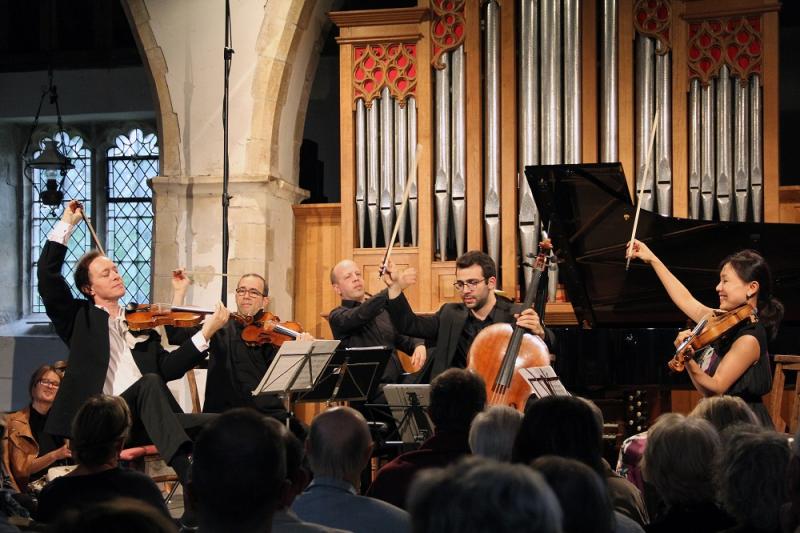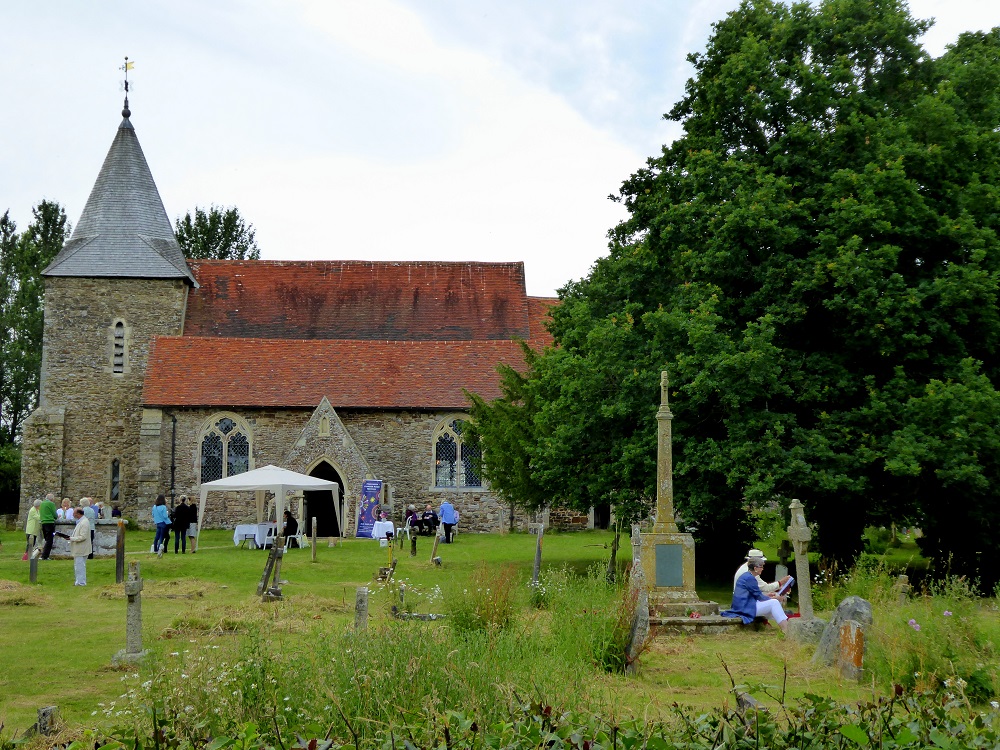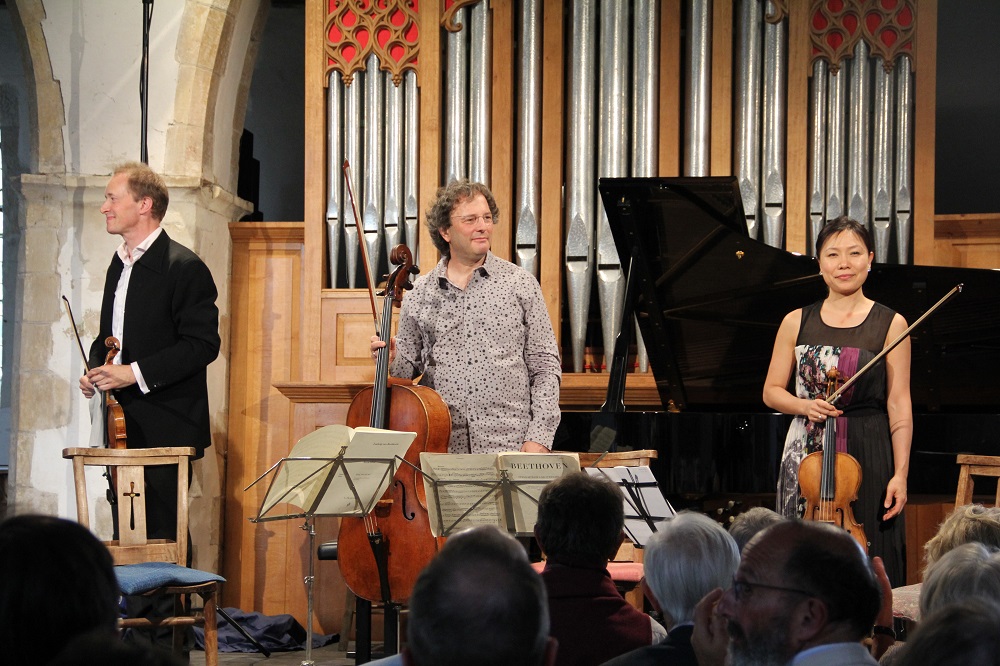Anthony Marwood and Friends, Peasmarsh Festival - elegies in a country church | reviews, news & interviews
Anthony Marwood and Friends, Peasmarsh Festival - elegies in a country church
Anthony Marwood and Friends, Peasmarsh Festival - elegies in a country church
World-class chamber music in a secluded corner of Sussex

A magnificent riven oak with gnarly branches stands in the secluded graveyard of SS Peter and Paul's Church Peasmarsh, near Rye. Transport it in your mind to Flexham Park in a very different part of Sussex, imagine it struck by lightning and it could be one of that twisted group which Elgar encountered on a short walk from his Bedham cottage in the summer of 1918, subsequently permeating his massive and masterly Piano Quintet with the ghost story surrounding them.
The Peasmarsh Festival, celebrating its 20th anniversary this year, is a very English project, albeit with international artists. Its driving forces are leading violinist and local resident Anthony Marwood and cellist Richard Lester, celebrated both as soloists and for their work with the Florestan Trio to 2011 (there will be a reunion with pianist Susan Tomes, among other distinguished performers, in the celebratory Wigmore concert on 25 November). From humble beginnings their ambition has stretched to four days of concerts - I just missed the big one, with the Britten Sinfonia in the rather bigger church of St Mary's Rye on Saturday night - and well-supported educational work with local schools.
The construction of the main playing area - a semi-circular platform in front of the organ in the nave - encourages intimacy and involvement from the amphitheatre of listeners, a very different experience from squarely facing instrumentalists playing before or behind a chancel arch (this one, though splendid in its Norman design, with two lions carved in ironstone, is too narrow for any activity within). 
More important still, the juxtaposition, as in any imaginative programme, cast both composers in a fresh light. You have to wonder why Sciarrino veers so drastically away from letting the violin do what it does best - to sing - and into the rarefied world of sometimes feathery, sometimes scratcy harmonics (according to Richard Wigmore's note, when Carolin Widmann asked him why, he replied "Because I am harmonics"). But here these ghostly variations on Paganini's 24 Caprices were like the spectral interstices, the numinal world, around the relative solidity of Purcell's praise-singing. And after the last, almost symphonic Capriccio, Marwood joined his colleagues for the magnificent Purcell Fantasia Upon One Note, the only one of his set for five players.
Ghosts hovered around the early evening concert, too - and not just in the elegies of 1918. Beethoven's early C minor String Trio is full of doubts, introspections and fury between its more elegant utterances. Marwood is now a master both of the civilised turn of phrase and the eruptions; Huang and Lester, predictably, were very much in turn with the riven nature of the piece (all three pictured below). To hear the syncopated drive of the Scherzo at such close quarters was practically to levitate with the players. 
The 61-year old Elgar was already, as he himself put it, "a knight of ghosts and shadows" when that same year he rented the cottage of Brinkwells near Fittleworth in West Sussex. Clearly the chanting of the Spanish monks, somewhat ludicrously assigned the roles of those lightning-struck trees, is the starting-point, but the composer's infatuation with Brahms and Schumann shows in the personal and extrovert veins which follow, transfigured into a very individual elegy bursting with ideas; the lilting Moorish dance is another, unanticipated strand. The players rose passionately to the challenge, with heartbreaking post-Brahmsian eloquence from Huang and Pogossian in the central Adagio and ghost-whispers where necessary. They all understood that the Falstaffian robustness with which the finale tries to battle all the ghosts remains a personal matter, however emphatic the triumph. No one in this very vocal and attentive audience seemed unmoved at the end.
rating
Explore topics
Share this article
The future of Arts Journalism
You can stop theartsdesk.com closing!
We urgently need financing to survive. Our fundraising drive has thus far raised £49,000 but we need to reach £100,000 or we will be forced to close. Please contribute here: https://gofund.me/c3f6033d
And if you can forward this information to anyone who might assist, we’d be grateful.

Subscribe to theartsdesk.com
Thank you for continuing to read our work on theartsdesk.com. For unlimited access to every article in its entirety, including our archive of more than 15,000 pieces, we're asking for £5 per month or £40 per year. We feel it's a very good deal, and hope you do too.
To take a subscription now simply click here.
And if you're looking for that extra gift for a friend or family member, why not treat them to a theartsdesk.com gift subscription?
more Classical music
 BBC Proms: Ehnes, Sinfonia of London, Wilson review - aspects of love
Sensuous Ravel, and bittersweet Bernstein, on an amorous evening
BBC Proms: Ehnes, Sinfonia of London, Wilson review - aspects of love
Sensuous Ravel, and bittersweet Bernstein, on an amorous evening
 Presteigne Festival 2025 review - new music is centre stage in the Welsh Marches
Music by 30 living composers, with Eleanor Alberga topping the bill
Presteigne Festival 2025 review - new music is centre stage in the Welsh Marches
Music by 30 living composers, with Eleanor Alberga topping the bill
 Lammermuir Festival 2025 review - music with soul from the heart of East Lothian
Baroque splendour, and chamber-ensemble drama, amid history-haunted lands
Lammermuir Festival 2025 review - music with soul from the heart of East Lothian
Baroque splendour, and chamber-ensemble drama, amid history-haunted lands
 BBC Proms: Steinbacher, RPO, Petrenko / Sternath, BBCSO, Oramo review - double-bill mixed bag
Young pianist shines in Grieg but Bliss’s portentous cantata disappoints
BBC Proms: Steinbacher, RPO, Petrenko / Sternath, BBCSO, Oramo review - double-bill mixed bag
Young pianist shines in Grieg but Bliss’s portentous cantata disappoints
 theartsdesk at the Lahti Sibelius Festival - early epics by the Finnish master in context
Finnish heroes meet their Austro-German counterparts in breathtaking interpretations
theartsdesk at the Lahti Sibelius Festival - early epics by the Finnish master in context
Finnish heroes meet their Austro-German counterparts in breathtaking interpretations
 Classical CDs: Sleigh rides, pancakes and cigars
Two big boxes, plus new music for brass and a pair of clarinet concertos
Classical CDs: Sleigh rides, pancakes and cigars
Two big boxes, plus new music for brass and a pair of clarinet concertos
 Waley-Cohen, Manchester Camerata, Pether, Whitworth Art Gallery, Manchester review - premiere of no ordinary violin concerto
Images of maternal care inspired by Hepworth and played in a gallery setting
Waley-Cohen, Manchester Camerata, Pether, Whitworth Art Gallery, Manchester review - premiere of no ordinary violin concerto
Images of maternal care inspired by Hepworth and played in a gallery setting
 BBC Proms: Barruk, Norwegian Chamber Orchestra, Kuusisto review - vague incantations, precise laments
First-half mix of Sámi songs and string things falters, but Shostakovich scours the soul
BBC Proms: Barruk, Norwegian Chamber Orchestra, Kuusisto review - vague incantations, precise laments
First-half mix of Sámi songs and string things falters, but Shostakovich scours the soul
 BBC Proms: Alexander’s Feast, Irish Baroque Orchestra, Whelan review - rapturous Handel fills the space
Pure joy, with a touch of introspection, from a great ensemble and three superb soloists
BBC Proms: Alexander’s Feast, Irish Baroque Orchestra, Whelan review - rapturous Handel fills the space
Pure joy, with a touch of introspection, from a great ensemble and three superb soloists
 BBC Proms: Moore, LSO, Bancroft review - the freshness of morning wind and brass
English concert band music...and an outlier
BBC Proms: Moore, LSO, Bancroft review - the freshness of morning wind and brass
English concert band music...and an outlier
 Willis-Sørensen, Ukrainian Freedom Orchestra, Wilson, Cadogan Hall review - romantic resilience
Passion, and polish, from Kyiv's musical warriors
Willis-Sørensen, Ukrainian Freedom Orchestra, Wilson, Cadogan Hall review - romantic resilience
Passion, and polish, from Kyiv's musical warriors
 BBC Proms: Faust, Gewandhausorchester Leipzig, Nelsons review - grace, then grandeur
A great fiddler lightens a dense orchestral palette
BBC Proms: Faust, Gewandhausorchester Leipzig, Nelsons review - grace, then grandeur
A great fiddler lightens a dense orchestral palette

Add comment